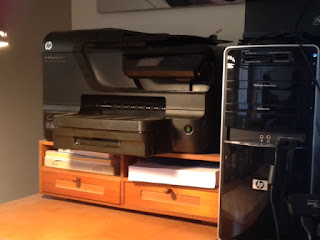Well, I am already a week late on getting this blog post
out. Not a good start on Finally Get Organized, but I am hanging in there and
decided to record my progress.
First, back up your
data – This is a great suggestion, because I did lose some of my
information that I had on an external hard drive. I took this drive last summer
with me to my summer home and I could not access any of the data. Plus the last
time I did a backup was the previous November. Lucky for me only my genealogy supporting
documents were on this drive, and my genealogy database was on Dropbox along
with the media file attached to it. So I might have lost some documents that I
save first to my external hard drive, then I create my source citation and
attach the document to the citation. If I failed to attach it to my citation, I
at least have my citation and I am able to re-find the item and save it again.
Therefore, I have been trying to come up with a monthly backup plan, such as a
cloud based option along with another external hard drive option. Also, I will
be copying my genealogy folder from my external hard drive to a flash drive,
with a folder called “working” and any new data will be place into the working
folder and the rest of the flash drive will be for reference only. This flash drive is all I will take with me to
my summer home. My next step is to
research cloud storage.
Decide on a genealogy
management program – For me this is Family Tree Maker. I have been using
this software package since about 1997. Now that Ancestry.com plans to retire
this software package, doesn’t mean I am jumping ship quite yet. However, I
have started learning RootsMagic before Ancestry’s announcement and I am
looking at cleaning my FTM files in case I need to switch quickly to another
program.
Starting with yourself,
ensure you’ve entered your personal data and that of the three older
generations by that surname in your chosen genealogy management program. This is my first project I am handling this
week. I know I have those three generations in my program, but I am going to
revisit each of these individuals, verify the place names, the citations and
any media files attached. I will make sure that they are complete, and if I am
missing anything, to create a to-do list of the missing items.
Set aside a 3-ring
binder for your surname – This I started years ago, because didn’t we all
start with our surnames (maiden name for me)? ;-)
Label oversize tabbed
3-ring dividers and insert in the surname binder – I must admit that I am
missing this item. However, I am not real big on binders either. I see where Ol’
Myrt is going with this, but I already have file folders in my hanging file
drawer separated by the suggested generations.
Therefore, I don’t know if this is really what I want to do at this
time.
Place the 4 family
group sheets behind the appropriate generation dividers in your surname binder –
Again, if I am staying with my hanging file folder system, I will put those
family group sheets as the very first item in my file folders.
Scan and file photos
and documents relating to each of these four generations in your surname/maiden
name binder – This is exactly what I already have in each of my file
folders. Ol’ Myrt suggested downloading documents from the Internet and this is
exactly what I have done. I also have printouts of every census record found
for these people.
As soon as you’ve
scanned the, place all important “must save” photos and documents in
top-loading page protectors. Done and done.
She stated that the rest of the photocopies may be discarded unless you
are a die-hard paper-oriented genealogist. Yep, I am, I want paper especially
for my direct line ancestors.
Create an
introduction for those that follow – Great idea, having an introduction to
quickly orient those who find your work later. You hate to have someone just
throw away your paper files and erase or discard your digital work too.
Now the hard work, doing all the little steps that make up
the introduction. I must admit, this is going to take me more than a week. I
could easily see that I could use a binder just for this introduction.
Explaining my file naming conventions, the locations of my files and my filing
system, listing all my database files, where they are stored on my computer and
which on-line websites might have a version too and how in-depth of a version.
Finally, adding a “genealogy
codicil” to my will. I guess I need a will first. All I know is that I have
threated my children, that if they get rid of my genealogy, that I will come
back and haunt them. I guess this will not hold up in a court of law.
This week’s checklist has me looking at my genealogy with a
whole new pair of eyes. Now all this
extra work might feel as if it takes the “fun” out of genealogy and from making
new discoveries, however it also allows me to make sure my research is complete
and meaningful to the next generation after me.
Back to doing all the steps.






